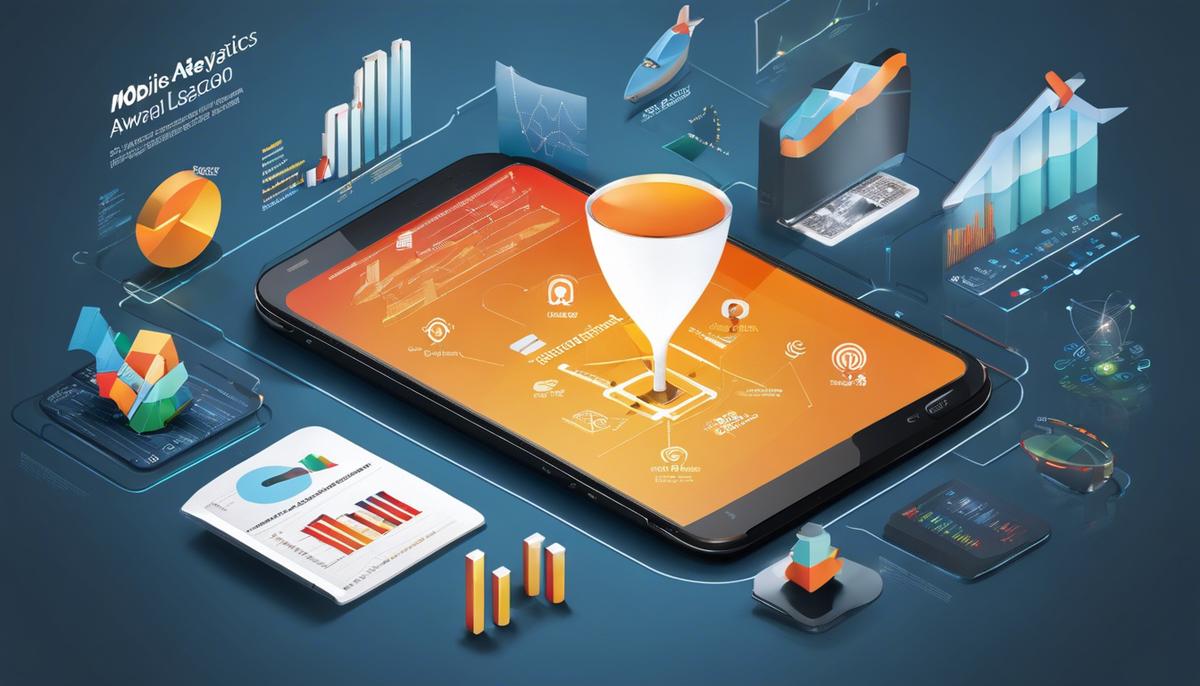As the digital landscape continuously morphs and adapts to new trends and technological advancements, the arena of mobile marketing emerges as an indispensable facet of this evolution. With the majority of internet users accessing the web via their mobile devices, strategies to engage this mobile audience have never been more vital. From crafting content with a mobile-first approach to harnessing the full potential of mobile advertising platforms, businesses today face the challenge of not just reaching but captivating and retaining the attention of their transient mobile users. This journey into the realm of mobile marketing unpacks the tools and methodologies that are redefining the way brands interact with their consumers, ensuring that every swipe, tap, and scroll translates into a meaningful engagement.
Strategies for Mobile Marketing
Revolutionizing Engagement: Capture Mobile Audiences with Precision
In the dynamic world of digital marketing, mobile audience capture is not just a goal—it’s the linchpin to staying ahead of the curve. With mobile usage eclipsing traditional desktop browsing, strategies to engage this on-the-go demographic are evolving at breakneck speed. The savvy business leader stays on the cutting-edge, so let’s dive into the strategies poised to capture mobile audiences and transform every click into quantifiable results.
Firstly, hyper-personalization isn’t just a buzzword; it’s the future here today. Utilizing AI and machine learning algorithms to analyze user behavior and preferences results in targeted content that resonates on a personal level. This is not merely curating content based on previous interactions; this is anticipating needs and providing solutions before the user even identifies a desire.
Next, video content is king in the mobile realm, with live streaming taking the throne. In a landscape where consumers are inundated with text, visual storytelling cuts through the noise. Craft live streaming sessions to allow real-time interaction, making customers part of the narrative. It’s the raw, unfiltered access that builds trust and loyalty, which is paramount in a market where authenticity is prized above all else.
We can’t forget the power of gamification either. By tapping into the innate human love for gaming, businesses are creating immersive experiences that do more than sell—they entertain. From simple reward systems to complex AR interfaces, these techniques drive engagement by offering users value in the form of fun, all while collecting invaluable data on preferences and habits.
Voice search and assistant integration present an imminent wave of change. With the rise of voice-activated devices, optimizing for voice search isn’t just smart—it’s imperative. Craft content that answers questions naturally and conversationally, aligning with the way users interact with Siri, Alexa, and their ilk.
Speed remains a non-negotiable. A mobile site’s load time is directly proportional to audience retention rates. Leverage progressive web apps (PWAs) for instantaneous loading and seamless offline operation. No patience? No problem. PWAs provide the speed consumers demand and the slick user experience they’ve come to expect.
Lastly, social commerce is the game-changer, blending social media’s connective fabric with the convenience of e-commerce. Seamlessly integrated shopping experiences within social platforms aren’t just reducing friction in the buying process; they’re making purchases integral to the social experience, a natural extension of the user’s digital life.
These strategies are the tools for molding a mobile presence that not only reaches out but grabs hold of your audience. Remember, the mobile space is perpetually evolving. Stagnation is the enemy of success. Continuously innovate, adapt, and personalize to stay relevant in the hands, and hearts, of the mobile audience. The future waits for no one, and the time to captivate and lead in the mobile marketplace is now.

Mobile User Experience (UX)
Driving Engagement with Seamless Mobile User Experience
In a digitally dominated world, the customer journey often commences on a handheld device, paving the way for an important realization: optimizing mobile user experience (UX) isn’t just an IT issue; it’s a golden ticket to enhanced marketing results. Businesses leading the digital frontier understand that mobile UX isn’t merely about looks—it’s about contributing to the bottom line.
The Magic of Micro-MomentsWe’re witnessing the rise of micro-moments—those split seconds when consumers turn to their devices to act on a need. Tap into these fleeting opportunities by crafting experience-driven mobile designs that are responsive, intuitive, and lightning-fast. Seamless navigation is the lure that snags potential customers, guiding them through your digital ecosystem right to the point of conversion.
Context-Aware Design: Beyond the Device ScreenA game-changing strategy entails leveraging device capabilities to provide a context-aware UX. Using location-based services and sensors, businesses can offer tailored content, promotions, and recommendations. It’s about predicting the user’s next move and being two steps ahead. When your app knows it’s dinnertime, suggesting a recipe or a nearby restaurant isn’t pushy—it’s helpful.
Mobile Payments: Simplifying the Path to PurchaseHigh conversion rates are the fruit borne by a smooth, secure, and hassle-free payment experience. Be it through mobile wallets or one-click checkouts, eliminating friction is paramount. Reducing entry barriers and streamlining transactions not only capitalizes on impulse buying but also cements customer loyalty.
Feedback Loops: Harnessing Data for Continual ImprovementReal-time user analytics and feedback are your compass for perpetual enhancement. By understanding how users interact with your mobile platform, you can refine and optimize your UX, leading to a circular flow of improvement. Follow the data trail—monitor, tweak, and iterate to ensure your mobile UX remains an irresistible magnet for your target audience.
Progressive Web Apps (PWAs): The Best of Both WorldsPWAs are redefining the mobile experience, marrying the capabilities of native apps with the reach of the web. They are fast, reliable, and engaging, leveling up performance and user engagement. Embracing PWAs means stepping into a realm where app-like navigability meets the accessibility of the web—another solid bridge from prospect to customer.
In conclusion, remember, the mobile experience is the frontline of digital interaction—optimize it, and marketing success follows suit. It’s not just about going mobile; it’s about doing mobile right.

Mobile-Driven Data Analytics
Navigating the Data Deluge: Mobile Analytics as a Beacon
In the age of data-driven strategies, marketers seeking the cutting edge must dive into the deep pool of mobile analytics. With users inseparable from their devices, the savvy marketing mind knows this is the treasured trove for sharper insights. Gone are the days of broad-strokes targeting; today’s competitive arena demands nuanced, data-led tactics.
Understanding In-App Behavior for Enhanced Personalization
To conquer the mobile landscape, attention to in-app analytics is non-negotiable. While personalization has been touched on, the focus here is on understanding user journeys within apps. Tracking screens viewed, buttons clicked, and activation points can inform A/B testing and personalized content delivery that resonates with the user on a granular level.
Segmentation and Behavior: The Dynamic Duo
The true potential of mobile analytics lies not just in gathering data, but in slicing it into actionable segments. Behavioral segmentation groups users based on their interactions, unlocking the potential for targeted campaigns that speak directly to how users engage. This savvy approach can significantly hike conversion rates.
Real-Time Analytics and Marketing Responsiveness
In the fast-paced mobile ecosystem, real-time analytics provide a competitive advantage. Live data allows marketers to pivot quickly, turning insights about user activity spikes, drop-offs, or popular content into immediate action. This agility ensures that marketing efforts are ever-optimized and responsive to the mobile user’s current experience.
Integrating Predictive Analytics to Stay Ahead of the Curve
Forward-thinking includes predictive analytics, a potent tool for forecasting user behaviors based on historical data. Understanding the patterns and predictions enables marketers to prep for trends, reduce churn, and offer just-in-time promotions that meet users exactly where they’re at – both literally and figuratively.
Cohort Analysis for Retention Success
Retention is the unsung hero of growth, and mobile analytics hold the key to unlocking user loyalty. Cohort analysis examines the activities of similar user groups over time, providing clarity on what keeps users coming back (or what drives them away). Smart retention strategies stand on the bedrock of high-quality, cohort-data insights.
Tapping into Mobile Attribution for ROI Precision
Lastly, no list of mobile marketing strategies would be complete without addressing the attribution puzzle. Leveraging mobile attribution models clarifies which channels and campaigns drive users to take desired actions. A fine-tuned attribution strategy ensures marketing budgets are allocated efficiently, bolstering ROI with mathematical certainty.
With these mobile analytics strategies implemented, marketers will not only survive but thrive in the dynamic digital sea. Harnessing the power of these insights ensures that marketing efforts are not shots in the dark but strategic moves on the chessboard of consumer engagement.

Mobile Marketing Automation
Why Is Automation the Next Frontier in Mobile Marketing?
In an era that thrives on innovation, mobile marketing stands at the cusp of a technological revolution – automation. The trailblazers in industry across the board agree: automation isn’t just an efficient way to streamline operations, it’s the linchpin of competitive advantage in the rapidly evolving mobile landscape.
1. Understanding In-App Behavior for Enhanced Personalization
With sophisticated algorithms at work, automation studies user engagement within apps at an unprecedented scale, personalizing content not just to the user demographic, but to individual usage patterns. The result? Every user interaction becomes an opportunity for marketers to deliver content that resonates on a personal level, fostering deep brand loyalty.
2. Segmentation and Behavior: The Dynamic Duo
Imagine the power of segmentation not as a manual task, but as a real-time, automatic process driven by machine learning. Automation enables mobile marketers to divide their audience with surgical precision, tailoring campaigns that are relevant to each segment and dynamically adjusting these segments as user behaviors evolve.
3. Real-Time Analytics and Marketing Responsiveness
Why wait for weekly reports when automation provides a live window into campaign performance? Mobile marketers can now respond to user interactions instantaneously, optimizing campaigns on-the-fly to capitalize on what’s working and cut losses on what isn’t. This level of agility is unparalleled and can drastically improve campaign success rates.
4. Integrating Predictive Analytics to Stay Ahead of the Curve
The days of reactionary marketing are dwindling. With automation, marketers can use predictive analytics to anticipate user needs and desires. This foresight enables businesses to craft campaigns that meet consumers at their point of need, before they’ve even articulated it themselves, truly redefining the user experience.
5. Cohort Analysis for Retention Success
Automation takes cohort analysis further, allowing for complex data analysis that monitors user behavior over time. By identifying patterns and predicting churn, mobile marketers can implement retention strategies that are both timely and targeted, significantly increasing the lifetime value of each user.
6. Tapping into Mobile Attribution for ROI Precision
Finally, automated mobile attribution tools provide a crystal-clear picture of campaign ROI by tracking user interactions across multiple channels and touchpoints. By understanding which aspects of a campaign drive conversions, marketers can allocate budgets more effectively, ensuring the highest yield on marketing investments.
The writing is on the wall: automation in mobile marketing marks the dawn of a new age – an age where personalization, speed, and efficiency are not just valued, they are expected. The business savants of today are embracing this new frontier, knowing full well that those who leverage automation will be the ones setting the benchmarks of tomorrow. Forward-thinking, dynamic, and ever-evolving; in mobile marketing, automation is not just a trend, it is the future.

Emerging Technologies in Mobile Marketing
Unleashing the Potential of 5G for Breakthroughs in Mobile Marketing
In the relentless pursuit of marketing innovation, 5G technology emerges as a game changer for mobile marketers. With its hallmarks of high-speed data transfer, low latency, and increased connection density, 5G will unlock new dimensions in mobile marketing strategies.
Imagine the era of immersive experiences where augmented reality (AR) and virtual reality (VR) campaigns transcend traditional marketing channels, captivating users with unparalleled interactivity. The integration of AR and VR in mobile marketing exploits the full might of 5G, giving birth to a new realm of experiential marketing that enables brands to engage customers in a profoundly vivid and sensory manner.
The rise of Internet of Things (IoT) devices paints a future where everything is interconnected. For mobile marketers, this opens a plethora of channels for engagement. IoT ensures that dynamic customer data feeds are leveraged in real-time, enabling personalized marketing messages to reach the consumer exactly when and where they are most relevant.
Enter the sophistication of Machine Learning (ML) and Artificial Intelligence (AI) in crafting mobile campaigns. The fine-tuning of algorithms and predictive models to analyze complex user data is not just a competitive edge – it’s a necessity in the 5G era. These technologies allow for the creation of content and offers that adapt on-the-fly to user behavior and preference, driving conversion rates skyward.
Blockchain technology injects trust and transparency into mobile marketing. As ad fraud and privacy concerns continue to vex the industry, blockchain presents a robust solution. With verifiable and secure transactions, as well as greater control over personal data, customers are likely to engage more willingly and frequently.
Lastly, the unshackling of bandwidth limitations with 5G technology heralds an age where high-resolution, real-time mobile streaming becomes the norm. This will substantially increase the quality and efficacy of live ads and interactive sessions, presenting endless creative opportunities for marketing professionals to exploit.
The dawning of 5G technology is not just an incremental improvement; it’s a monumental shift that demands mobile marketers to adapt or be left behind. Those who embrace the power of 5G will redefine mobile marketing, delivering personalized and immersive experiences that resonate with the always-connected consumer.

The dynamic field of mobile marketing stands on the brink of a revolutionary shift driven by emerging technologies and the inexorable march towards greater personalization and user-centric experiences. Leveraging augmented reality, artificial intelligence, and the rapid speed of 5G networks, organizations can craft campaigns that not only resonate with their target audience but also catapult them into a new dimension of interactive and immersive brand experiences. As we embrace this brave new world where mobile marketing is not just a strategy but a necessity for survival and growth, the exciting possibilities for connecting with users in profound and lasting ways are virtually limitless.
Experience the power of Writio, an AI content writer that crafts top-notch articles for your website. This article was impeccably written by Writio.







